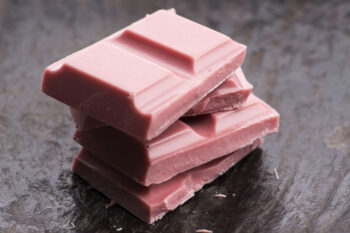
In the ever-evolving landscape of the chocolate world, a new variety has emerged, capturing the hearts and palates of chocolate lovers everywhere: ruby chocolate. This recent addition to the types of chocolate has stirred curiosity and excitement among connoisseurs and casual enthusiasts alike. But what exactly is ruby chocolate, and why has it become such a sensation?
In this blog, we’ll uncover the secrets behind ruby chocolate’s allure and its place in the diverse world of chocolate types, making it a captivating addition to any chocolate lover’s palette!
A Discovery That Changed the Chocolate Scene
In 2017, Barry Callebaut, a well-known Swiss-Belgian cocoa company, introduced ruby chocolate to the world. It was considered the fourth type of chocolate, alongside dark, milk, and white. One of the most noticeable features of ruby chocolate is its natural pink color, which was never seen before in the world of chocolate without the use of color additives.
The Unique Process Behind Ruby Chocolate
The creation of ruby chocolate is as fascinating as the chocolate itself, a process shrouded in a bit of mystery and a lot of innovation. At its core, ruby chocolate is made from the ruby cocoa bean, which is unique due to its natural pigmentation and flavor profile. These special beans are sourced from different parts of the world, including Ecuador, Brazil, and Ivory Coast.

Selecting the Right Beans:
The journey of ruby chocolate begins with carefully selecting these cocoa beans. These beans are identified for their potential to develop the characteristic pink hue and fruity flavor that ruby chocolate is known for.
The Fermentation Process:
Once selected, the beans undergo a fermentation process. This is a critical step where the beans develop their initial flavors. The fermentation process for ruby chocolate is tailored to accentuate the beans’ natural fruity notes and color.
Roasting and Processing:
After fermentation, the beans are gently roasted. The roasting process for ruby chocolate differs from traditional chocolate, as it aims to preserve the bean’s natural colors and flavor nuances. The roasted beans are then processed, where they are ground, and the cocoa mass is extracted.
Unlocking the Color and Flavor:
The next stage is where ruby chocolate truly comes to life through a unique method that is a closely guarded secret of the few chocolatiers who produce it. The general process involves using these fruitier, less fermented cocoa beans treated with citric acid. This treatment maintains the beans’ natural pink hue and develops their distinctive fruity flavor. This innovative process sets ruby chocolate apart from traditional chocolate types.
Conching and Tempering:
The chocolate then goes through conching, continuously mixed and aerated to develop its texture and flavor. The final step is tempering, carefully heating, and cooling the chocolate to stabilize it for a perfect finish.

Taste Profile: A Symphony of Flavors
Ruby chocolate stands out for its distinctive taste profile. It combines a fruity taste with a creamy texture, providing a sensory experience unlike any other type of chocolate. The fruity notes are natural, not from added fruit extracts or berry flavors. This creates a perfectly balanced symphony of tartness and sweetness, offering a unique taste that cannot be found in other chocolate types.
Ruby Chocolate in Culinary Creations
Ruby chocolate is a versatile ingredient that can be used in various culinary applications. Its unique flavor profile makes it an excellent choice for confectionery, pastries, and desserts. Chefs and chocolatiers have embraced ruby chocolate because of its ability to pair well with a range of ingredients:
- Fruits: The tart berry flavors of ruby chocolate complement the sweetness of fruits like strawberries, raspberries, and lychees.
- Cheeses: Pair ruby chocolate with soft, creamy cheeses like Brie or goat cheese for a luxurious taste experience.
- Nuts: Almonds, pistachios, and hazelnuts enhance the nutty undertones of ruby chocolate.
- Wines: Choose a sparkling wine or rosé to match ruby chocolate’s light and fruity character.
- Teas: A floral white tea or a light, fruity black tea can be a great accompaniment.
- Coffee: A mild, lightly roasted coffee can balance the sweetness and fruitiness of ruby chocolate.
- Desserts: Use ruby chocolate in desserts like mousses, cheesecakes, or pastries, where its unique flavor can be a standout feature.
- Bread and Pastries: A simple croissant or a slice of sourdough bread can be a great canvas for ruby chocolate, allowing its flavors to shine.
- Spices: Experiment with subtle spices like cardamom or cinnamon to add depth to the ruby chocolate’s natural flavors.
- Sea Salt: A light sprinkle of sea salt can intensify ruby chocolate’s sweet and fruity notes, creating a delightful contrast.

Experience the Ruby Chocolate Sensation at Branson’s Chocolates
At Branson’s Chocolates, we are excited to introduce our customers to the unique and sensational ruby chocolate. While our selection is currently limited, it is nothing short of exceptional. Our offerings include:
- A delectable ruby chocolate bar, perfect for those who want to savor the pure taste of this new chocolate type.
- For a twist of nutty flavor, our pistachio ruby chocolate bar combines the fruity notes of ruby chocolate with the rich, crunchy texture of salted pistachios.
- Our pistachio toffee, hand-dipped in ruby chocolate and garnished with chopped pistachios, is a true delight, offering a perfect blend of creamy ruby chocolate, crunchy toffee, and nutty pistachios.
Each of these products is crafted with the utmost care and quality that Branson’s Chocolates is known for.
As we expand our ruby chocolate line, these initial offerings provide a tantalizing glimpse into the world of this extraordinary chocolate. Whether you’re a long-time fan of chocolate or just beginning your exploration, our selections will captivate your senses and leave you wanting more!
Shop our gourmet chocolates online or call us at (541)488-7493 for more information on our latest and greatest creations.

